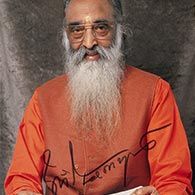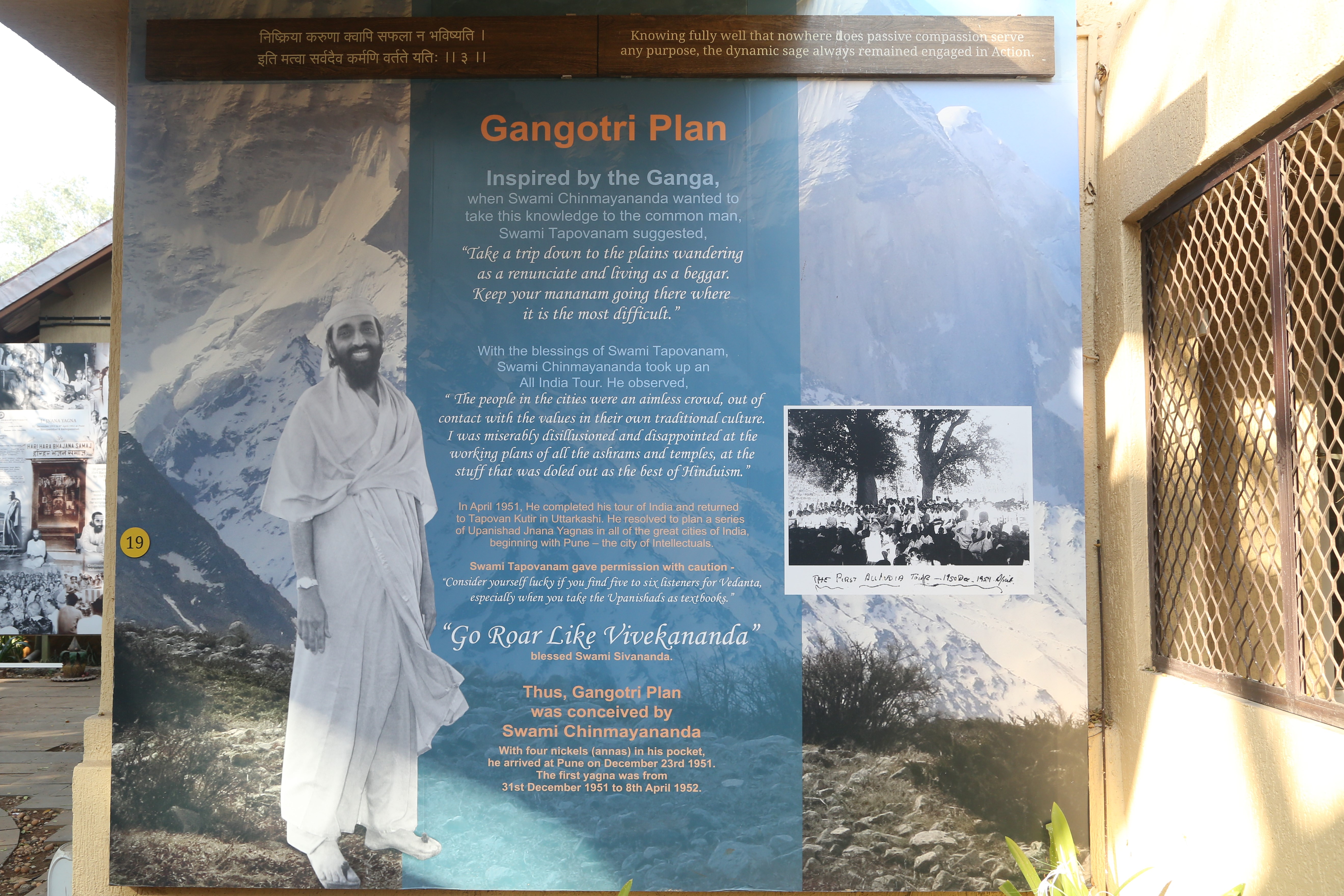Nishkriyakarunaakvaapisaphalanabhavishyati
Itimatvaasarvadaivakarmanivartateyatihi
Knowing fully well that nowhere does passive compassion serve any purpose,
the dynamic sage always remained engaged in Action.
The Gangotri Plan
At Gangotri, is a place called ‘Faquirstan[Place of the Wise], where the elderly Mahatmas discussed Adi Shankaracharya’s commentaries among themselves and asserted vehemently some or the other conclusion, often without must logical argument. Slowly Chinmaya left them for his own personal reflection and meditation.
It was after one of these encounters, while he was sitting on a large boulder on the banks of the Ganga in its infant state that the inspiration to take the Essence of the Hindu Scriptures to the common man dawned in the heart of Swami Chinmayananda.
The Story of Chinmaya Pradeep began with this moment and after the flash-back of his childhood, youth, spiritual student days, has come back to that moment in time.
There were obstacles to actualizing his plan. His own Guru Swami Tapovan was a staunch believer that a Swami should lead a life of study, reflection, contemplation and teach Vedanta to those who came to him.
Nearly a month later, Swami Tapovanam suggested to Chinmaya that he take a trip down to the plains wandering as a renunciate and living as a beggar among those he had once emulated. “This will rub out your ego! To have the experience of the Divine is not enough. You must be able to keep that vision through all your activities. Keep your mananam going there where it is the most difficult. When you face the adversities of life there, you will not fall into the dangers of complacency and self-contentment in your spiritual discipline” said Swami Tapovanam. With the blessings of Swami Tapovanam, in May 1951 Swami Chinmayananda took up an All India Tour. He observed, that “When people don’t know who you are, they consider you an inconvenient beggar, a worthless monk, an unproductive member of the community. An they insult you with looks of abhorrence as if you were something the cat dragged in. This kind of discipline is the best cure for the ego-disease” wrote Swami Chinmayananda of that Journey.
The people in the cities were an aimless crowd, out of contact with the values in their own traditional culture.
“I was miserably disillusioned and disappointed at the working plans of all the ashrams and temples, at the stuff that was doled out as the best of Hinduism.”
A well of empathy began building up in Chinmaya, which would be the source of his overflowing love for his countrymen and which would sustain him for over 40 years in serving them tirelessly.
In November 1951, Swami Chinmayananda completed his tour of India and returned to Tapovan Kutir in Uttarkashi. He resolved to plan a series of Upanishad Jnana yagnas in all of the great cities of India. He had taken the term Jnana Yagna from the Bhagavad Geeta(Ch.XVIII Verse 70). He planned to teach directly the scriptures to the masses.
For his the first lecture series Swami Chinmayananda considered Poona ideal, for it was a city of the intellectuals.
Swami Tapovanam gave his permission but warned, “Consider yourself lucky if you find five to six listeners for Vedanta, especially when you take the Upanishads as textbooks.”
Swami Sivananda guided Swami Chinmayananda “Go Roar Like Vivekananda”.
Thus, Gangotri Plan was conceived by Gurudev Swami Chinmayananda. With four nickels (annas) in his pocket, clothes on his back, a trunk filled with an accumulation of notes and books with the words, “Divine Mission” carefully lettered on its top, Swami Chinmayananda arrived at Pune. On Dec. 23rd 1951, he gave his first talk - Let us Be Hindus. To your left is the statue of Sri Swami Tapovanam. Behind it is the logo of Sandeepany Sadhanalaya - A Premier Institute to study Vedanta Systematically and be a Missionary for Hinduism.
As you move towards your left, you enter the Hinduism area. The entire area that comes up after the Gangotri plan, till the lotus pond, is the Hinduism area along with the Early Jnana Yagnas leading to the formation of Chinmaya Mission.
The Gangotri Plan
“You can’t treat this knowledge like your newspaper business.’ he admonished the student. Respecting his Guru’s convictions, Swami Chinmayananda put the idea aside, again and again.
Swami Chinmayananda, taking courage literally in both hands, declared his intentions once again to his Guru. “You don’t know what you are asking for! You will get permanently caught up in the wheel of work. We start the action and later the activities take charge of us!” said Swami Tapovanam.
It was not that Swami Tapovanam did not have sympathy for the suffering masses. He had written in “Wanderings in the Himalayas”: “I believe that no man who loves his native land and who has some power of thought still left in him can traverse these regions without feeling a touch of melancholy for the loss of our great culture.”
Dynamic Chinmaya
To do activities because one is restless and incapable of sitting quietly is different from serving people dynamically inspired by a vision. Its not born out of insecurities or need to prove oneself. This is born out of compassion.
In the world there are two types of people –
1. Some who feel compassion, but do nothing or not capable of doing it. (Karunamaya and asamartha)
2. Capable of doing, but feel no compassion(Samartha but no karuna)
Swami Chinmayananda had both, like many other Missionaries. Eg. Shankaracharya, Samarth Ramdas, Vivekananda etc.
Active compassion comes from one’s conviction that this is the need of the hour and this should be done. No one told him to do. From his study, reflection, understanding that this is the beauty of our culture and this should go to maximum people, his Active compassion was born.
Active compassion is also born out of dispassion. People will ridicule, condemn and oppose but one’s conviction drives a person to act inspite of it.
Swami Tapovanam consents
Design Notes
Gangotri Plan
A graphic printed panel represents the time that Swami Chinmayananda decided to go down to the plains (Pune) and spread the true teachings of Hinduism to the masses through the Jnana Yagnas. The exhibit for this section consists of a graphic panel and a life-size picture of Gurudev.



